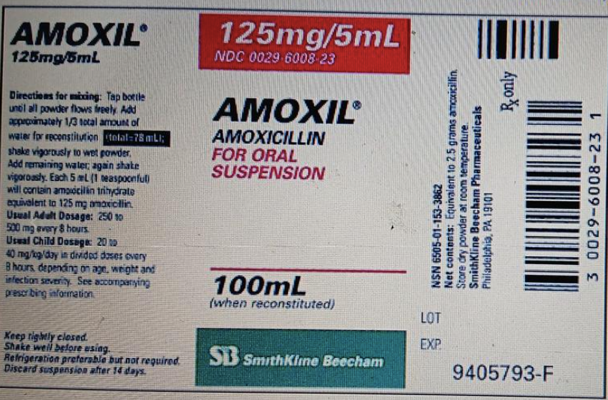The order reads "amoxicillin 20mg/kg/dose PO every 8 hours." The child weighs 33 pounds. Using the label below, how many mL will you administer per dose? (Enter a number only, answer to the nearest tenths place)

The Correct Answer is ["12"]
1. Convert the child's weight from pounds to kilograms:
There are approximately 2.2 pounds in 1 kilogram.
33 pounds / 2.2 pounds/kg = 15 kg (approximately)
2. Calculate the total milligrams of amoxicillin needed per dose:
The order is for 20 mg/kg/dose.
The child weighs 15 kg.
20 mg/kg * 15 kg = 300 mg
3. Determine the concentration of the amoxicillin suspension:
The label shows the concentration is 125 mg/5 mL.
4. Set up a proportion to find the volume (in mL) needed:
125 mg / 5 mL = 300 mg / x mL
5. Solve for x:
Cross-multiply: 125x = 300 * 5
125x = 1500
x = 1500 / 125
x = 12 mL
Answer: You will administer 12 mL per dose.
Nursing Test Bank
Naxlex Comprehensive Predictor Exams
Related Questions
Correct Answer is C
Explanation
A) Hypersensitivity reaction: A hypersensitivity reaction typically involves an immune response where the body reacts to a substance as if it were harmful, leading to symptoms like rashes, swelling, or difficulty breathing. However, low hemoglobin and low white blood cell counts are not typical signs of a hypersensitivity reaction. This would involve more common allergic symptoms like itching or swelling, rather than hematologic changes.
B) Paradoxical reaction: A paradoxical reaction refers to when a medication causes an effect opposite to the expected result. For example, a sedative causing agitation instead of sleepiness. While a paradoxical reaction can involve unexpected effects, the hematologic changes (low hemoglobin and white blood cell counts) in this scenario do not align with this type of response.
C) Idiosyncratic reaction: An idiosyncratic reaction is an unusual or unexpected response to
a medication that is not related to the drug's pharmacologic properties or the dose given. It may be related to genetic factors or other individual differences in how a person metabolizes or responds to the drug. The low hemoglobin and low white blood cell counts in this case are unusual effects of diphenhydramine and suggest an idiosyncratic response, where the client’s body is reacting in an unexpected way to the medication.
D) Anti-cholinergic reaction: Anti-cholinergic reactions are typically related to symptoms caused by the blocking of acetylcholine, such as dry mouth, blurred vision, urinary retention, or constipation. While diphenhydramine has anti-cholinergic properties, the symptoms described (low hemoglobin and white blood cell counts) are not typical of an anti-cholinergic reaction.
Correct Answer is B
Explanation
A. "Take this medication with a small sip of water or on an empty stomach":
This response is not ideal for calcium carbonate. Calcium carbonate is typically taken with food to help increase its absorption and to reduce the risk of gastrointestinal discomfort, such as constipation or bloating. Taking it on an empty stomach could cause irritation and is not the standard guideline for this medication.
B. "This medication should be taken two hours before other medications":
This is the most appropriate response. Calcium carbonate can interfere with the absorption of other medications, particularly those that require an acidic environment for proper absorption, such as certain antibiotics (e.g., tetracyclines) and thyroid medications. Therefore, taking calcium carbonate two hours before or after other medications helps to prevent such interactions.
C. "Place this medication underneath your tongue and let it dissolve":
Calcium carbonate is typically taken orally in tablet form, not sublingually. The medication should not be dissolved under the tongue, as it is not designed for that route of administration. This would be an incorrect instruction.
D. "You can take as many doses of this medication as you need":
This statement is not accurate. Calcium carbonate should be taken as prescribed and in the correct dosage to avoid side effects such as hypercalcemia or kidney stones. Overuse of calcium supplements can lead to serious complications, and it should not be taken "as needed" without specific instructions from the healthcare provider.
Whether you are a student looking to ace your exams or a practicing nurse seeking to enhance your expertise , our nursing education contents will empower you with the confidence and competence to make a difference in the lives of patients and become a respected leader in the healthcare field.
Visit Naxlex, invest in your future and unlock endless possibilities with our unparalleled nursing education contents today
Report Wrong Answer on the Current Question
Do you disagree with the answer? If yes, what is your expected answer? Explain.
Kindly be descriptive with the issue you are facing.
